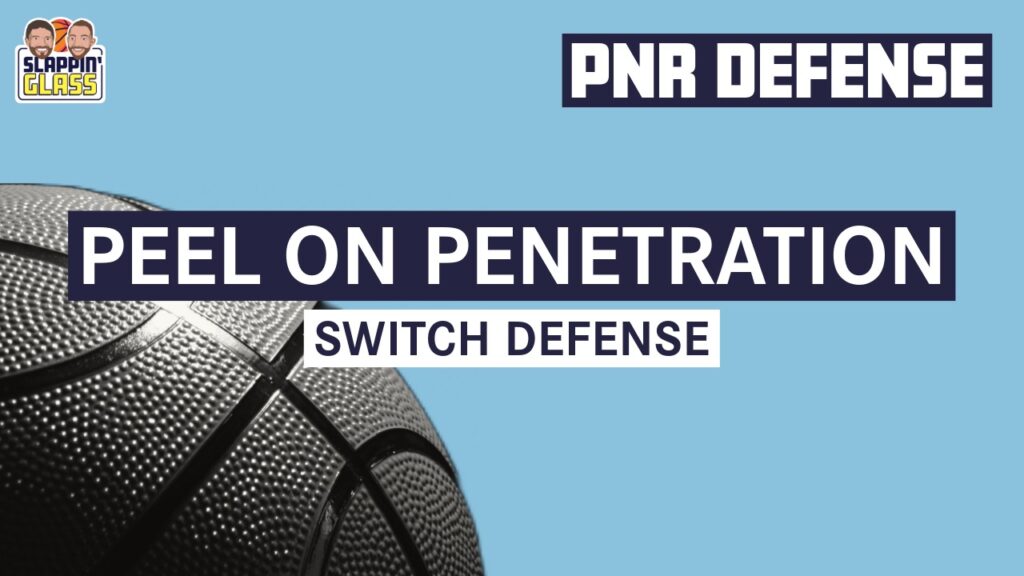A few months ago, we highlighted an offensive strategy for attacking a switching defense in the PNR called “Drive the Wake.” {🔒} In this approach, the ballhandler attacks a perimeter mismatch by driving into a temporarily open gap left behind by the roller, creating an opportunity that looks something like this…
During our study of this concept, we were reminded of a defensive strategy we have previously highlighted, where teams can opportunistically deploy the Peel Switch on perimeter penetration to wall off guards attempting to attack the gap created by the roll, while simultaneously solving mismatches without committing an extra defender. Therefore today, we are revisiting this strategy, examining its execution and merits.
Switch & Peel on Penetration
First, here’s a quick look at the “Switch & Peel on Penetration” executed in real time…
Execution of the Coverage
1. Guards Fight Against the Seal: After the switch, the defensive guard must work to “front” the post and avoid being sealed on the roll. This positioning allows the guard to stay mobile, read the penetration, and effectively initiate the “Peel Switch.”
2. Guard Switches Up “Hard and Fast”: As the offensive guard begins to penetrate, the defensive guard must switch back “hard and fast” to close off any shooting gaps and disrupt the ballhandler’s ability to throw a quick lob. This timing is crucial in aiding the defensive big executing the “Peel Switch” to get back to their original matchup. Above, notice how quickly the guard engages the ballhandler on the switch. ⬆️
3. Defensive Big Applies Ball Pressure: The defensive big plays a key role by applying immediate and consistent ball pressure on the ballhandler. This pressure serves the purpose of putting the ballhandler into a less controlled speed dribble, reducing their ability to recognize the peel switch and scan the floor for passing options. Effective ball pressure disrupts the rhythm of the penetration and buys time for the Peel Switch to take place seamlessly. Here’s a look at nice pressure on the ball, this time after a “Hedge to Switch”…
Forcing the Peel Switch
As demonstrated in the above example, defenses can elect to be more proactive in forcing penetration back into the guard and the subsequent peel through the use of an aggressive “Hedge to Switch” strategy. Reminiscent of the “Hedge and Plug” {🔒} coverage, the big will aggressively hedge out on the switch, in an effort to funnel the ballhandler back into the guard, who has switched over the top of the screen. The guard sits on top of the rolling big while keeping an eye on the ball in preparation of the switch.
Merits of the Scheme
One of the best aspects of this coverage is that, when executed correctly, it can solve the resulting mismatches while allowing the other three defenders to stay home on their matchups. As with any switching scheme, the coverage can effectively neutralize the action by making it a 2v2 game. However, the resulting mismatches can create additional problems that may force the defense to commit another defender to the ball, such as sending a “Hit” {🔒} to the perimeter mismatch…
Through the use of the “Peel Switch,” especially when switching a guard onto a less threatening post option, the defense has a tool to resolve mismatches, wall off the guard at the rim, and prevent the defense from getting caught in a scramble situation.
Zooming In: Tying it all together, in the example above the ballhandler attempts to drive the gap behind the roll (Drive the Wake). However, the defensive guard capitalizes on this opportunity to jump into the gap, putting himself back on the ball, and triggering the big to execute the Peel Switch back onto his original matchup. Meanwhile, the remaining three defenders can stay attached to their matchups without having to shrink into gaps, leaving the ballhandler with no outlets or advantage on the ball.
Especially at the higher levels, guards have become very adept at navigating PNR Coverages and manipulating Help and Tag defenders. A coverage like this is more unusual to operate against and the unfamiliarity of it can help the defense force the ballhandler into shots or reads they’re not as comfortable handling. Whether it’s used opportunistically, or as more of a coverage (Hedge Switch to Peel), it’s ability to disorient and stand up the offense can help a defense steal a possession or two throughout the course of a game. To learn more on this strategy SG+ Members can now view the full updated breakdown on SGTV!
